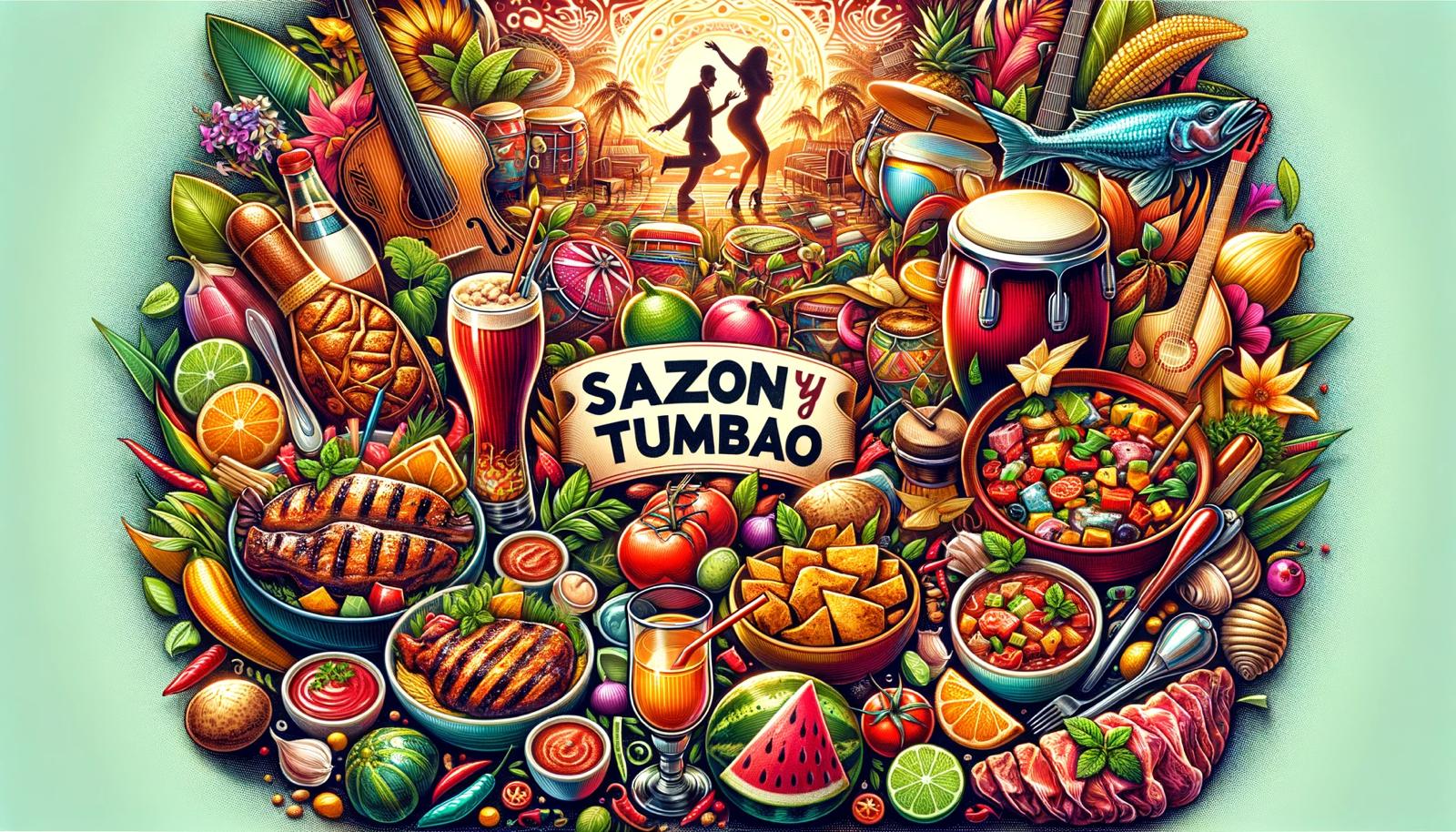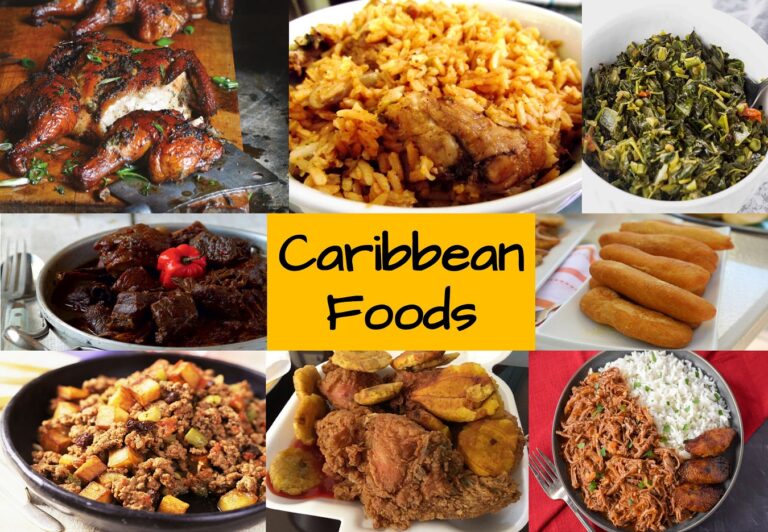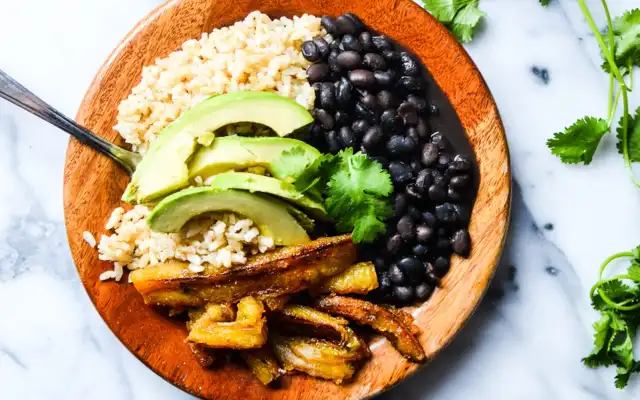In the heart of the Caribbean, where the sun kisses the sea and the rhythm of life sways to a tropical beat, there exists a dish that transcends mere sustenance. It’s more than food; it’s an experience—an ode to tradition, flavor, and the vibrant tapestry of cultures that converge on the islands. Ladies and gentlemen, allow me to introduce you to the tantalizing world of Roast Pork Mofongo.
Imagine a rustic wooden table, the air thick with anticipation. The sun, like a benevolent chef, casts its golden glow upon a plate that holds secrets passed down through generations. Here, the humble plantain takes center stage. Not just any plantain, mind you—ripe, golden, and ready for its transformation. It’s sliced, fried to a crisp, and then mashed with a purpose that borders on reverence.
But wait, there’s more. Enter the roast pork—a symphony of flavors, slow-cooked to perfection. The crackling skin yields to reveal juicy, succulent meat infused with spices that dance on your taste buds. Garlic, like a mischievous companion, weaves its magic into every fiber of this dish. The result? A harmonious blend of sweet, savory, and garlicky goodness that defies description.
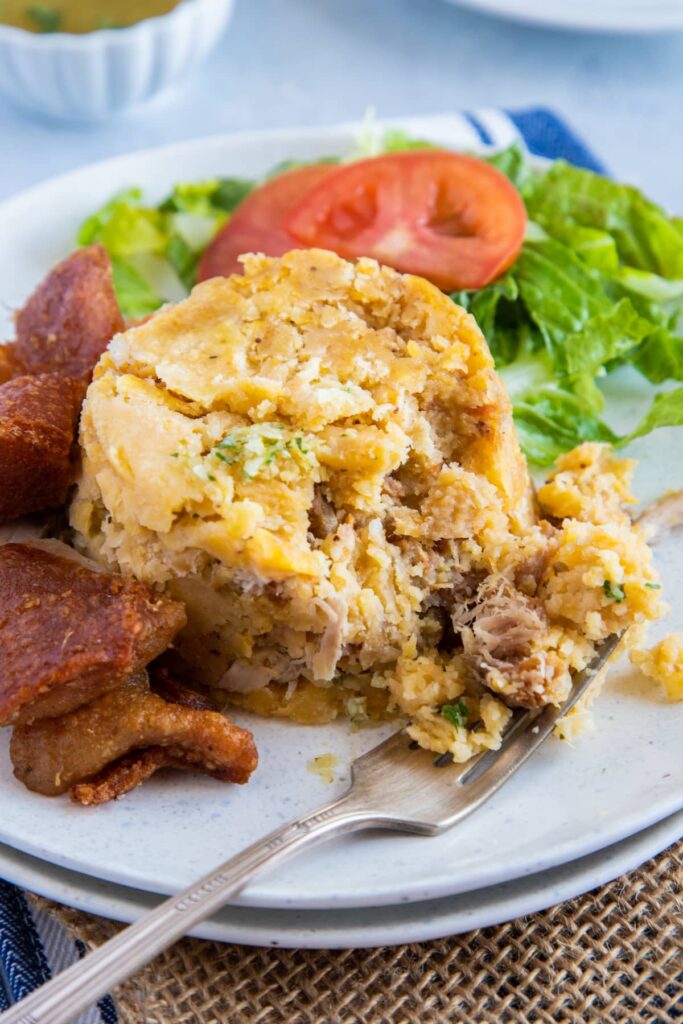
So, food adventurers, buckle up. We’re about to embark on a journey where every bite tells a tale, where the aroma transports you to sun-kissed shores, and where Roast Pork Mofongo reigns supreme. Ready? Let’s dive in.
What Is Mofongo?
Mofongo is a traditional Puerto Rican dish that celebrates the humble plantain. Here’s the lowdown on this flavorful Caribbean delight:
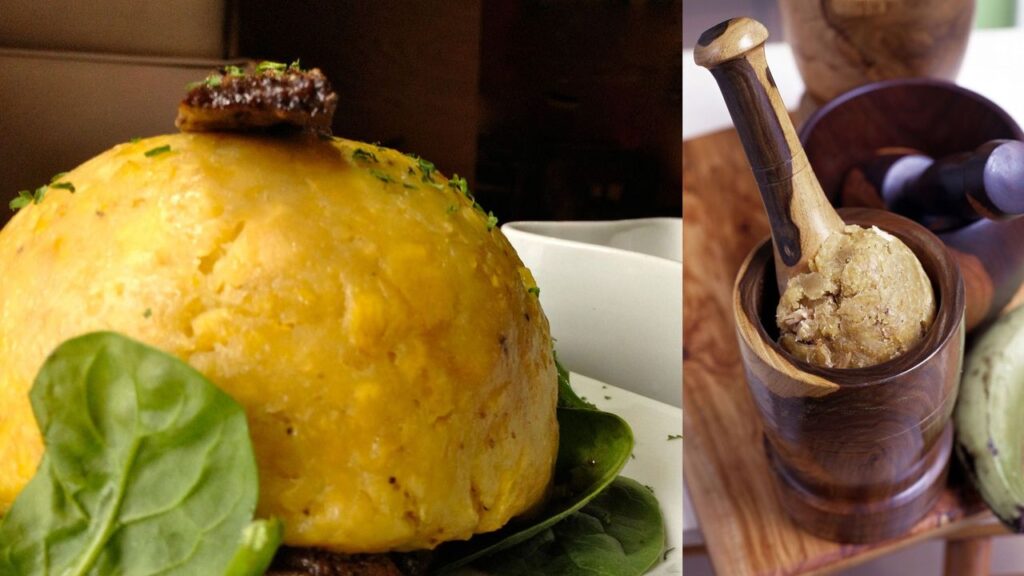
The Ingredients:
- Green Plantains: The star of the show! These unripe plantains are firm, starchy, and perfect for mofongo.
- Garlic: For that aromatic kick.
- Pork Cracklings (Chicharrón): These crispy bits of pork add both protein and flavor.
- Salt: A pinch to enhance all the other flavors.
- Oil: Used for frying the plantains.
The Process:
- Frying the Plantains: Heat up some oil and fry the green plantains until they turn a glorious golden brown. This step is crucial—it gives the plantains their irresistible texture.
- Mashing Time: Grab a pilón (a wooden mortar and pestle) and get ready to mash. Combine the fried plantains, garlic, and pork cracklings. The pilón is your secret weapon—it ensures the perfect consistency.
- Shape It Up: You can go classic and shape your mofongo into balls or get creative with cups or ramekins. Either way, you’re in for a treat.
Serving Suggestions:
- Broth or Sauce: Mofongo loves company! Serve it alongside a flavorful broth or sauce. Beef stew, chicken broth, or a zesty garlic mojo—take your pick.
- Variations: While the traditional version includes pork cracklings, feel free to experiment. Some folks add shrimp, chicken, or even lobster for extra indulgence.
The Art of Roasting Pork
Roasting pork to perfection is both a science and an art. Let’s delve into the steps that ensure your roast pork emerges succulent, flavorful, and with that coveted crispy crackling:
1. Selecting the Cut:
- Opt for a pork butt or pork shoulder (boneless or with bone). These cuts have the right balance of marbling, which contributes to tenderness and flavor.
- Avoid using a pork loin for this method; it won’t yield the same results.
2. Preparation:
- Take the pork roast out of the fridge and let it sit at room temperature for 30 minutes to an hour. This ensures even cooking.
- If your roast has a thick layer of fat on the outside, trim it down to a thin coating. Save the excess fat for other uses—it’s flavor gold!
3. Low and Slow Cooking:
- Preheat the oven to 300°F (150°C).
- Rub the pork roast with a simple seasoning blend of black pepper, garlic powder, and salt.
- Roast the pork in the preheated oven for 30 minutes.
4. The Resting Period:
- Remove the pork from the oven and reduce the heat to 325°F (165°C).
- Insert an instant-read thermometer into the thickest part of the center. The temperature should range from 80 to 110°F (27 to 43°C).
- Let the pork rest uncovered at room temperature until the internal temperature reaches 115 to 140°F (46 to 60°C). This takes about 30 minutes.
5. The Reverse Sear:
- Return the pork to the oven and continue cooking until the internal temperature reaches 145°F (63°C). This will take another 15 to 30 minutes.
- The reverse sear step ensures a crispy brown crust. Crank up the oven to a high temperature (around 475°F or 245°C) to achieve that beautiful exterior.
6. Final Resting:
- After achieving the desired internal temperature, let the roast stand uncovered at room temperature for 15 to 20 minutes before slicing and serving.
Remember, patience pays off when roasting pork. The result? A juicy, flavorful masterpiece with crackling that’ll make your taste buds sing!
Roast pork mofongo Recipe
get ready to channel your inner chef because we’re diving into the world of roast pork mofongo, a dish that’s going to turn your kitchen into the hottest spot in town. Let’s break it down:

Ingredients:
For the Roast Pork:
- 2 pounds of pork shoulder, cut into chunks (because everything’s better in bite-sized pieces)
- 4 cloves of garlic, minced (garlic is life, my friends)
- 1 teaspoon of salt (the essence of flavor)
- 1/2 teaspoon of black pepper (because a little kick never hurt)
- 1 teaspoon of oregano (for that herby goodness)
- 2 tablespoons of olive oil (liquid gold)
- 2 tablespoons of vinegar (for a zesty zing)
- 1 lime, juiced (citrus makes everything better)
For the Mofongo:
- 4 green plantains, peeled and cut into 1-inch chunks (the starchy backbone of our dish)
- Oil for frying (because we’re about to make these plantains sing)
- 4 cloves of garlic, minced (yes, more garlic)
- 1/4 cup of pork cracklings or bacon bits (for that salty, porky crunch)
- Salt to taste (seasoning is everything)
Instructions:
Roast Pork:
- Marinate the Pork: Mix the garlic, salt, pepper, oregano, olive oil, vinegar, and lime juice in a bowl. Add the pork chunks and marinate for at least 1 hour, or overnight if you’re really getting into the flavor game.
- Roast the Pork: Preheat your oven to 375°F (190°C). Place the pork and marinade in a roasting pan and cover with foil. Roast for about 1.5 to 2 hours, or until the pork is tender enough to write home about. Once done, shred it or cut it into smaller pieces. Reserve some of the juices for the mofongo.
Mofongo:
- Fry the Plantains: Heat oil in a deep skillet and fry the plantain chunks until they’re golden and tender. This usually takes about 5 to 7 minutes. Don’t crowd the skillet; give them some space to breathe.
- Mash the Magic: Drain the plantains on paper towels. Then, in a mortar and pestle (or a bowl with some elbow grease), mash the fried plantains with the minced garlic, pork cracklings or bacon bits, and a bit of the pork’s roasting juices to get everything nice and tasty. Season with salt to your liking.
- Mix in the Pork: Gently fold the roast pork into the mashed plantain mixture. If it’s feeling a bit dry, don’t be shy about adding more of the pork’s roasting juices to get it to a moist, but not soggy, consistency.
Mashing and Shaping Mofongo
- Frying the Plantains: Heat about 2 inches of oil over medium-high heat in a large skillet or deep fryer to 350°F. Peel the green, unripe plantains and cut them into 1-inch rounds. Fry the plantains until they turn golden and tender (approximately 4 to 6 minutes). Remove the cooked plantains from the oil and place them on a paper-towel-lined plate.
- Mash with Garlic: In a large bowl or mortar, put the garlic paste and add the fried plantains (you might need to do this in batches). Mash thoroughly using a mortar and pestle or a potato masher. The goal is to achieve a cohesive mixture.

Whether you choose balls or half-domes, your mofongo is ready to be savored! Serve it alongside a flavorful broth or sauce, and let the flavors transport you to the sun-kissed shores of Puerto Rico!
Serving and Pairing Roast pork mofongo
Roast pork mofongo is the ultimate comfort food masterpiece from the heart of Puerto Rico. Imagine taking green plantains, those steadfast soldiers of the fruit world, frying them up, mashing them with enough garlic to ward off any and all vampires, and then mixing in roast pork that’s so perfectly cooked it could bring a tear to a chef’s eye.
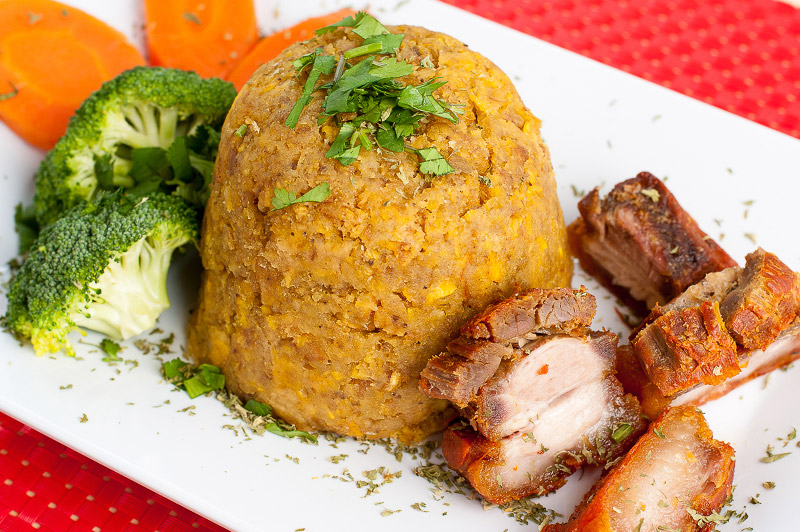
It’s like if comfort food had a heavyweight champion, mofongo would be rocking the belt. Served up in a glorious heap, it’s a dish that promises to hug your soul and fill your stomach with pure, unadulterated joy. Whether you’re soaking it in broth or letting it stand tall on its own, mofongo is more than just a meal—it’s an experience.
Final Analysis
Mofongo, that humble yet extraordinary dish, beckons us to explore beyond the plate. Mofongo’s roots intertwine like the gnarled branches of an ancient tree. It’s a fusion—a dance—of African, Taino, and Spanish influences. Mofongo wears different hats. Mofongo relleno—stuffed with meats or veggies. Mofongo mix is a delightful blend of green and sweet plantains. And then there’s trifongo, a trio of starches.
Each variation whispers stories of creativity and adaptation. Mofongo isn’t a hurried affair. It’s a labor of love—a symphony of flavors orchestrated by patient hands. When you savor it, you taste the history, culture, and soul of Puerto Rico.
So, food adventurers, as the sun dips below the horizon, let’s raise our forks to roast pork mofongo. May its flavors linger in our memories, reminding us that every meal is more than sustenance—it’s a celebration of life.
